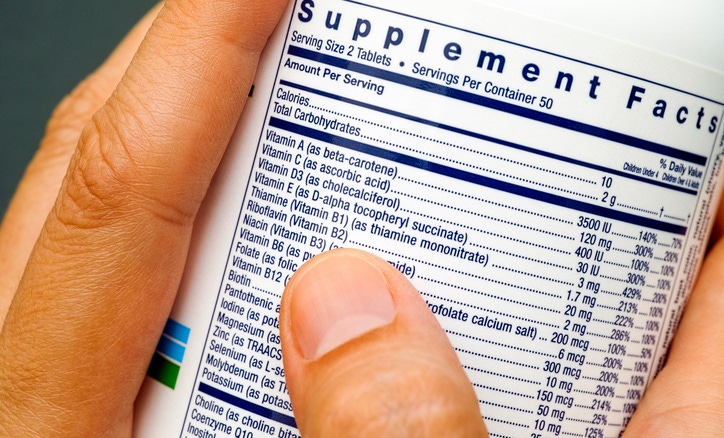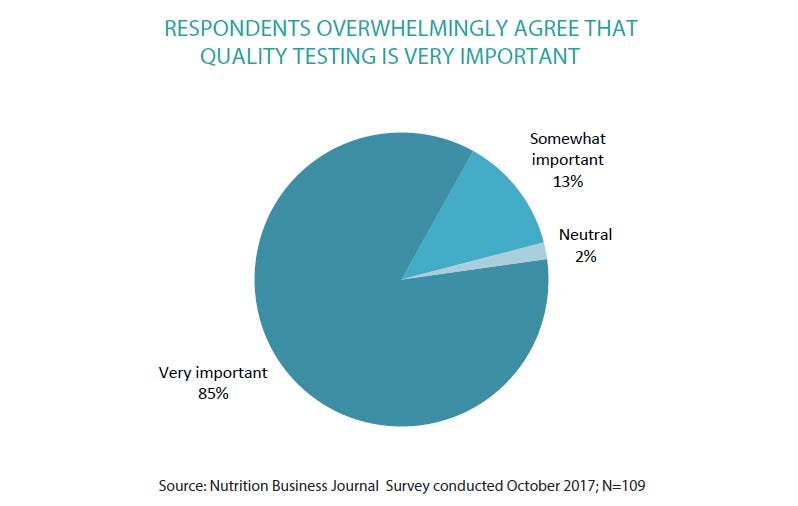April 10, 2018

The honorable dietary supplements industry is always screaming that its products are trustworthy, its ingredients are legit, and those sketchy companies that end up on 60 Minutes are far from the norm. Fair enough. The industry has made massive strides since DSHEA’s passage—in R&D, quality control, compliance, transparency, you name it.
Yet despite these countless improvements, a large contingent of companies still fall short in one key area: testing finished supplements for potency. These brands may test raw materials before blending. They might take great care throughout the manufacturing process. They may do just about everything right. But when it comes to confirming that each capsule, spoonful, tablet or tincture truly contains what its label claims, many brands don’t carry their products across the finish line.
Legal loophole
Supplement companies can get away with this because of a loophole in the law. “The GMPs don’t state that manufacturers have to do finished product testing for potency, mainly because some testing methods don’t exist yet,” says Elan Sudberg, CEO of Alkemist Labs. “They use that as a get-out-of-jail-free card, even though the reason these methods don’t exist is because companies haven’t paid for them to be developed.”
So while these brands aren’t breaking the law, they’re not necessarily following best practices, either. After all, it’s their responsibility to make sure consumers are getting safe, consistent, efficacious products every single time. But if they don’t test, can they really be sure their supplements contains the exact amounts of minerals or percentage of curcuminoids listed on the label? Or, when dealing with sensitive ingredients like caffeine or botanicals that interact with prescription meds, can they confirm their product is safe for consumers? “This is not about stopping at a stop sign so you don’t get caught,” Sudberg says. “It’s about stopping at a stop sign so you don’t kill a kid.”
The tricky part of testing finished supplements is identifying a method that’s fit for that specific formula—not just one of its components. “You can quantify how much caffeine is in a green tea powder,” Sudberg says. “But the moment you mix that green tea powder with another active such as resveratrol, the method you used to quantify the caffeine in the green tea powder is no longer valid.”
But again, the method needed may not exist. Unless you’re dealing with a very common ingredient, for which a pharmacopeia or industry trade group has published guidance, it probably doesn’t exist. However, if you just throw your hands up at this point, you are misinterpreting the GMPs, says James Neal-Kababick, director of Flora Research Laboratories. Still, he sees supplements manufacturers following this tack all the time.
“Some think that there not being a testing methodology out there exempts them from testing, but that’s not what FDA says,” insists Neal-Kababick. “FDA says if science doesn’t allow for testing, they aren’t going to push it—not that if you haven’t paid to develop a method, you are exempt.”
Despite any murkiness around testing requirements, this part of the law is crystal clear: every ingredient claimed in a product must actually be present in the product. “FDA’s position is that nobody is forcing you to do finished product testing, but if you are going to [be in this business], you need to comply with the regulations,” Neal-Kababick says. “You are supposed to ensure that your products meet label claims—and the only way to do that is to test them. I may complain about needing to pay someone to check my pipettes every day. But if I didn’t do it, I wouldn’t be a quality laboratory that provides compliant data.”
To be fair, there are certainly companies that do test their finished products for potency. These tend to be large, well-funded brands, companies with in-house labs, labels owned by pharmaceutical firms or contract manufacturers with major retailers as clients. “There is a good handful of companies that go above and beyond and pay us to develop methods for testing their finished products,” Sudberg says. “They know that if your label says X milligrams of caffeine per Y grams of green tea, you sure as hell better have a method for proving how you got there.”
But at the same time, the fact that a faction of supplements brand holders do not test could chip away at the industry claim of responsibility and self-regulation. “If you don’t test on output, you are leaving a very big exposure for someone else to find,” Neal-Kababick says. �“This industry is already under a lot of scrutiny, and when a media article comes out finding that a product isn’t what it claims to be, it tarnishes the whole industry’s reputation.”
Excuses, excuses
While some supplement companies cite the GMP loophole as a reason not to test finished products, many others don’t test out of pure ignorance—about regulations, ingredient interactions, manufacturing or multiple aspects of this business. “There are a lot of mom-and-pops who started something small that took off, and they have no knowledge that there is something called GMPs,” Neal-Kababick says. “They remain ignorant right until FDA shows up.”

Larisa Pavlick, vice president of regulatory and compliance at United Natural Products Alliance, saw plenty of companies in over their heads during her years as an FDA investigator. “Typically with the small and midsize companies, they have good intentions, but they are not quite there yet,” she says. “Mom-and-pops often don’t have the resources to do industry trainings or travel to trade shows. They just do what they know how to do, whether it’s making traditional herbal products or running an encapsulation machine.”
Lack of funds is another all-too-common roadblock. Testing finished products is not cheap, especially if it requires paying a lab to develop methodology. “When you blend minerals and vitamins with botanicals, it’s tough to test those finished products,” Pavlick says. “There is a lot of work and money involved in developing an appropriate monitoring and testing program. The resources are often just not there for smaller brands.”
And for brands that rely on contract manufacturers, many don’t grasp—or choose to ignore—that they are still on the hook for ensuring the end product is legit. “The responsibility always comes back to the brand holder, but when I’d audit them, they’d say they don’t test because they don’t manufacture the product,” Pavlick says. “Then, when we’d audit contract manufacturers, they’d say, ‘hey, it’s not our brand, so we don’t test.’ If companies weren’t specifically asking these manufacturers for finished product testing, they weren’t going to cut into their already small margins to do it.”
Some brand holders and contract manufacturers are well-versed in the GMPs but don’t believe finished product testing is even necessary. Usually, this is because they test inputs and feel that’s good enough, but in combined formulations, ingredients can interact, degrade or even be enhanced in a formulation. Pavlick says plenty of companies don’t fully understand this.
The other problem with relying solely on testing individual ingredients is the assumption that everything has gone perfectly during blending, encapsulation and every other stage of manufacturing—which isn’t likely. “As long as you have humans in the equation and are dealing with natural products, there are challenges,” says Neal-Kababick.
Issues commonly come up when working with myriad particle sizes, because differing densities can affect how well a mixture stays blended. “I have gone to facilities, popped the heads off drums and seen a powder completely change color from the beginning to the end of a lot,” Neal-Kababick says. “If you can validate that your mixing process keeps things uniform, you may be able to get away with less finished product testing, but why take that risk? It’ll only take one product showing up in Consumer Reports or on ConsumerLab to ruin a company’s reputation.” Or, for that matter, the reputation of the entire industry.
What is FDA’s role?
Traditionally, FDA hasn’t focused too heavily on finished product testing, which isn’t surprising since it isn’t required. But auditors have called out companies for testing incorrectly. For example, Sudberg cites a 483 sent to Beehive Botanicals. He says the company didn’t want to foot the bill for Alkemist Labs to develop a method to test gingerols in its finished product. So the lab used a method designed to detect ginger and stated that the method hadn’t been validated for a finished product. When FDA saw this, the feds called foul, claiming Beehive didn’t actually know the gingerol content because a fit-for-purpose method hadn’t been used.
Neal-Kababick believes these types of warning letters will become more common. “Because FDA inspectors have gotten training at Ole Miss (University of Mississippi), they are getting savvier and more detailed in their audits. We are seeing more warning letters about identity and testing methods,” he says. “I know companies that have been inspected five times with no problems, then the sixth time they got a letter.”
One way brand owners could minimize their risk potential during audits is to not get so specific on labels in the first place. “Sometimes it is scientifically impossible to validate quantity,” Sudberg says. “That’s why I tell companies to stop putting things on their labels that they can’t back up. They think consumers want this very specific information, but I’m not sure they do. If you put echinacea on the label versus echinacides, you are safe.”
According to Pavlick, this is a balancing act between differentiating your product and creating an unnecessary risk for your company. “As an investigator, I’d go through labels, pick at least three ingredients and ask for the testing and monitoring data,” she says. “If you mark the active constituent of ginkgo at X percentage, show me that’s true. If I were a brand owner, I think I’d avoid [listing those specifics] because I know that if I put it on my label, I’d have to substantiate it.”
Some would like the FDA to simplify matters by mandating finished product testing and spelling out more clearly which types of tests are required. But will that actually happen in today’s federal-budget-slashing, anti-regulatory political climate? Not likely.
“It’s nice to say FDA can solve this problem, but they don’t have the resources,” Pavlick says. “And, really, this is something we need to solve together as an industry. We have to step up and say finished product testing is the right thing to do to make sure our products meet quality standards.”
 This article appears in the third iteration of Nutrition Business Journal's Dark Issue, which looks at various forms of greed in the supplement industry. The full issue is available for purchase here.
This article appears in the third iteration of Nutrition Business Journal's Dark Issue, which looks at various forms of greed in the supplement industry. The full issue is available for purchase here.
About the Author(s)
You May Also Like





